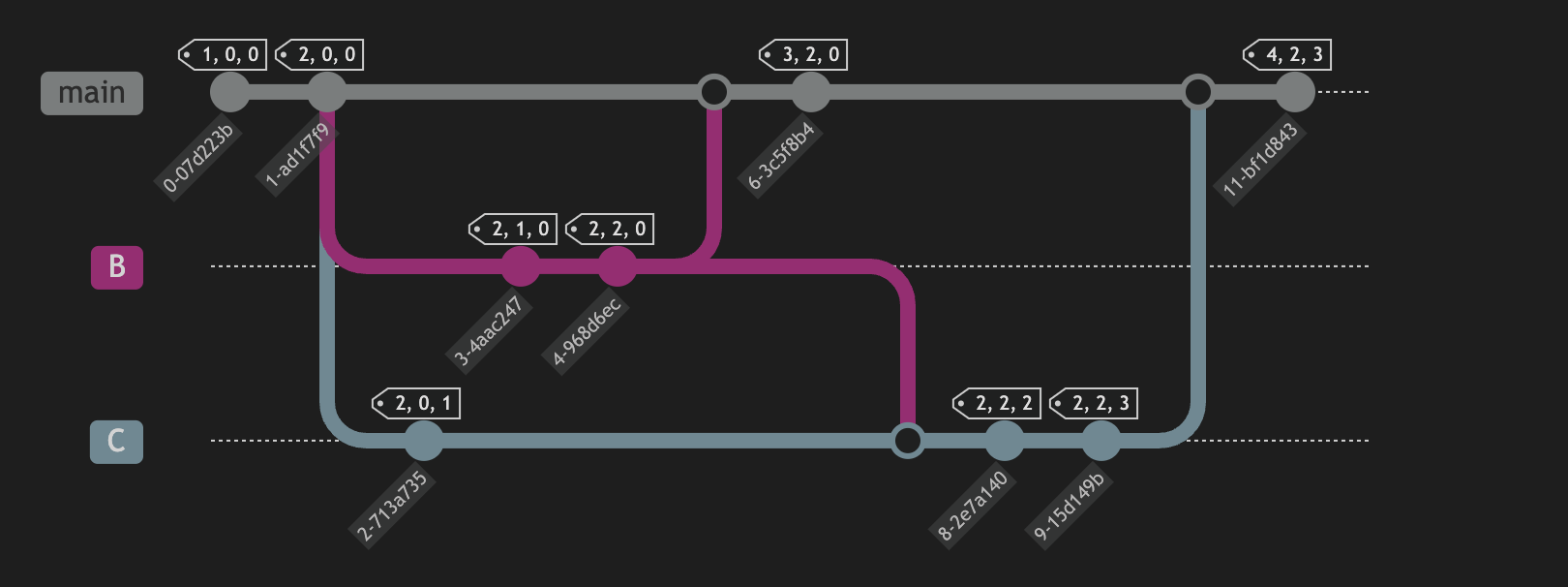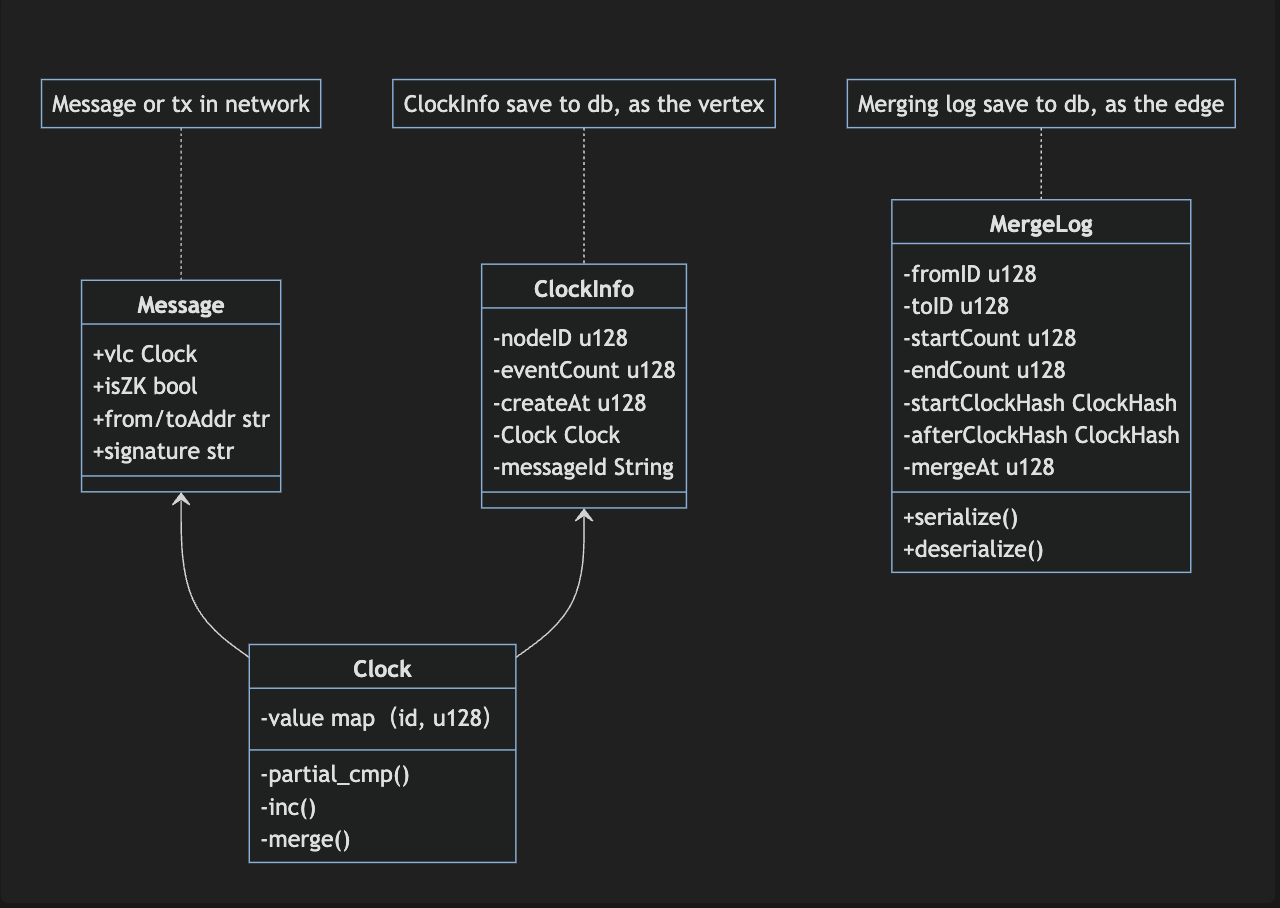Clock & P2P combined or optimizing
Clock & p2p
Verifiable logic clock & p2p, a novel verifiable logical clock system.
Guideline & Principles
Clock ( Reference COPS )
- L2 causality Replica group (similar Cohort, sub-network, or cluster, Maybe HLS certification)
- 1、CohortClock needs to be still asynchronous to update a batch of Txs & VLC in a cluster (DHT network).
- 2、Merge by VLC-defined algorithm, communicate by gossip Algo. (small world servers
cluster) - 3、Keep the size of the L2 causality network to prevent linear inflation of VLC space. v(May need to change DHT or Bootstrap logic)
- 4、runtime clock data pruning(when node online or offline)
- 5、 A random select leader or conductor must exist for submitting Rollup-tx(ZKP IVC), and conductor clock in each L2 epoch timestamp.
- L1 main-chain Hubs for security gatekeepers, consistency, and tokenization value layer.
- only accept cohort leader rollup tx and VLC data for a global up-to-date view of the entire network.
P2P & VLC
- SyncMessage: VLC state & hash of a batch of tx needs to sync to peers
- VLC state ZKP & txs MKT needs submit to L1 Hub for validation & global causal state
- Adjust DHT, Bootstrap Algo parameters to Limit network scale and size
Modeling & Data Structure
Simple Modeling
Suppose there were n nodes in cohort network, n is three in below graph. It looks like below, when start node running.

Data Structure
- Purpose
- Display clock’s state & change in global view.
- Related data structure as below:
- Message (Ref P2P Design) or Transaction
- VLC: Verifiable logical clock
- node_id
- MergeLog as edge, ClockInfo as vertex.
- main data structure for db saving and recovering the dag propagation graph about clocks.
- Message (Ref P2P Design) or Transaction

Persistence & DB
Clock data save to the KV db, LMDB for persistence for now.
Maybe the postgreDB or influxDB is a better choice for next step.
ClockInfo
- key:
nodeid-count-vertex, value:serde(ClockInfo)
- key:
MergeLog
- key:
fromid-fcount-toid-tcount-edge, value:serde(MergeLog)
- key:
CurCount, not must
- key:
nodeid, value:current_count
- key:
When needs to rebuild the dag of clock propagation,
- first use ClockInfo node to construct participant event line,
- then use MergeLog info for constructing the edge of the dag.
State Increment Sync & Separate Clock
Separate State & Clock
Because global data state is much big, so can’t gossip to other participants with so big data package. Separate full state and clock is must to do.
- But clock needs to reference transactions or message.
- So
message_idneeds add to ClockInfo.
- So
State Increment Sync
There are two methods for state increment sync, make events organize to merkle tree or just the native vlc structure.
- 1、Event merkle tree
- Transactions merkle tree in block header, just for light client quick verify.
- whether there is a transaction block in our design ?
not must
- whether there is a transaction block in our design ?
- World state MPT or merkle tree in memory
- whether there is a world state tree in our design ?
- Must be consensus algorithm & full transaction order.
not must - if not, it will cause state not consistency.
- Must be consensus algorithm & full transaction order.
- whether there is a world state tree in our design ?
- Transactions merkle tree in block header, just for light client quick verify.
So, we accept second method, just use native vlc structure to sync state directly.
- 2、direct sync by vlc
- first sync clock, then active pull diff events.
- init setup, pull from many peers neighbor by needs in parallel.
- All message types:
- ServerMsg:
- EventTrigger
- DiffReq
- DiffRsp
- ActiveSync
- ClientMsg: only send latest clock
- ServerMsg:
- Tips:
C_Arefer to the latest clock of node A,C_B: latest clock of node B.
Ledger Organization Modes
Ledger mode is another important issue, this topic leaves to the next step to discuss or design.
- DAG ledger
- DAG, not friendly to virtual-machine, and asset
- liner chain ledger
- liner chain, not friendly scalability
- Guideline & Principles
- Clock ( Reference COPS )
- P2P & VLC
- Modeling & Data Structure
- Simple Modeling
- Data Structure
- Persistence & DB
- State Increment Sync & Separate Clock
- Separate State & Clock
- State Increment Sync
- Ledger Organization Modes